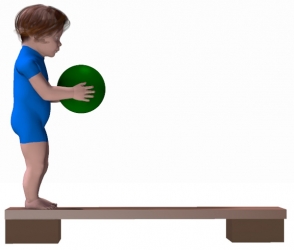A common assumption, held by physical and occupational therapists, is that balance is a generic process that can be improved by a set of activities that challenge balance responses/reactions.
An example is exercises standing on a rocker board to improve "balance" in a child who falls a lot. Therapists will often have favorite set of exercises to improve a child's balance.
The assumption that sitting or standing balance is a "thing" that can be addressed by a generic set of balance exercises is based on outdated accounts of motor control. It ignores present day understanding of the task and context specific nature of maintaining balance during functional tasks (Haddad et al 2013).
The basics of maintaining balance are well understood
Therapists' understanding of the basic mechanisms for maintaining balance is not in dispute.
1 Maintaining balance during task performance requires a set of anticipatory and ongoing adjustments of trunk and limb alignment to maintain the center of mass (COM) over the base of support (BOS).
2 Maintaining balance may also require changing the size and position of the BOS relative to the COM - often seen as a step.
3 Depending on the task, there may also be a need to increase muscle activity aimed at stabilizing the trunk and limbs to accommodate the impact of internal or external destabilizing forces impacting on the body.
|
Catching a soccer ball to the side in standing 1 Visual pickup provides information about the direction and speed of the ball. 2 The hands are moved forwards and to the side in preparation for catching the ball
3 Ball is caught
|
Balance responses and stability adjustments are task and context specific
Here is the bit that proponents of a generic approach to balance training are ignoring: balance and stability are task and context specific.
The balance and stability requirements - including the information pickup and extent and timing of responses - is different for different tasks. For example walking on uneven ground, up and down a slope, on a slippery or soft surface all require task specific postural and stability adjustments.
Reaching for, and picking up a jug of water differs depending on the action that follows - moving the jug to the side or pouring water into a cup.




Experience provides a set of basic strategies for similar tasks
Maintaining balance when performing an activity is learned through repeated practice.
Experience with a wide variety of tasks provides the individual with a "library" of strategies for maintaining balance in different situations. In computational accounts of movement control these stored strategies are referred to as priors or internal representations (Wolpert 2011).
When learning a new task, the movement brain is able to select from this library of "priors" a strategy that was developed for a similar task. This learned strategy is then adapted to suit the demands of the new task (Wolpert 2011).
Clinical implications: Poor balance is not a "thing"
Poor balance cannot be quantified or measured.
Tasks that require balancing on a small BOS are often used to measure balance: standing on one leg, walking on a narrow base.
However, performance on these tasks does not provide any information about the child's ability to perform the many daily activities that require finely tuned balance and stability responses to perform successfully at an age appropriate level.
A task and context oriented assessment and intervention provides a systematic approach to assessment and intervention
Assessment using a daily routines approach allows the child, parents and therapist to identify tasks that require attention.
If the parent is concerned about excessive amount of falls,assessment and intervention would include:
- Identifying the activities that lead to falls is a first step.
- The next step is to create assessment protocols that are similar to the situations that lead to the falls.
- Task assessment allows the therapist to identify factors that lead to performance difficulties
- A graded approach to task training is implemented.
Read more: Neuromotor Task Training
Bibliography
Haddad JM, Rietdyk S, Claxton LJ, Huber JE. Task-dependent postural control throughout the lifespan. Exerc Sport Sci Rev. 2013 Apr;41(2):123-32. https://www.ncbi.nlm.nih.gov/pmc/articles/PMC3608710/
Claxton LJ, Melzer DK, Ryu JH, Haddad JM. The control of posture in newly standing infants is task dependent. J Exp Child Psychol. 2012 Sep;113(1):159-65.
Claxton LJ, Haddad JM, Ponto K, Ryu JH, Newcomer SC. Newly standing infants increase postural stability when performing a supra-postural task. PLoS One. 2013 Aug 5;8(8):e71288. https://www.ncbi.nlm.nih.gov/pmc/articles/PMC3733978/
Wolpert DM, Diedrichsen J, Flanagan JR. Principles of sensorimotor learning. Nat Rev Neurosci. 2011 Oct 27;12(12):739-51. PDF

